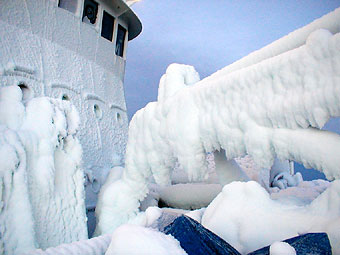

 | |||||||||
|
|
Journals 2006/2007Miriam Sutton
August 28, 2006 AM Location: Slope off Hopedale Trough (56° 44' 47.69" N, 57° 19' 46.49" W) We're in transit all day today and heading for the entrance to the Strait of Belle Isle. This strait is an 80-mile waterway that separates Newfoundland from Labrador and also serves as the gateway for the St. Lawrence Seaway. I am anticipating some whale sightings once we're in the strait and I'm still hoping for a few more icebergs as we head back closer to the coast and the Labrador Current. The past month aboard the CCGS Hudson has been truly amazing. The ship has handled the Labrador Sea beautifully, whether she was navigating through high seas or tranquil waters. I have learned from her proud crew that the CCGS Hudson's unique design is the foundation for the smooth ride in troubled seas. The ship, constructed in 1963 for scientific research, includes a champagne glass design which provides tremendous stability in rough seas. The Hudson can also handle thin ice. This strength came in handy during her circumnavigation of the Americas in 1969-70. The eleven-month voyage included stops in Mexico, South America, Antarctica, the Galapagos Islands, and Alaska before returning home to eastern Canada through the Northwest Passage. (See Iced Up Photo below.)
I feel truly lucky and grateful to have been assigned to such a time-honored ship of such legendary proportions. Today's Activity: Use a world map or globe to retrace the CCGS Hudson's circumnavigation of the Americas. Use the mileage scale to estimate the number of miles, or nautical miles, covered during the 11-month voyage. Word of the Day: Circumnavigate REMINDER: Record today's Sea Surface Temperature (SST) and the Air Temperature on the data table you created from the August 05 journal entry. |
||||||||
